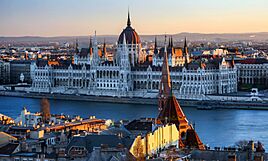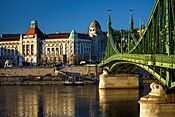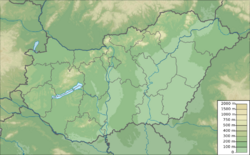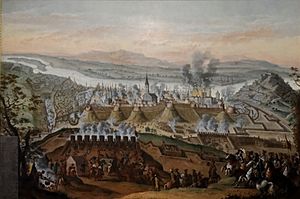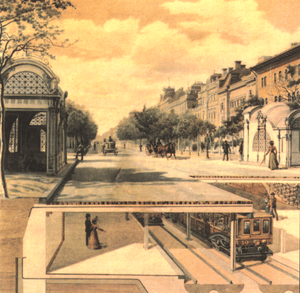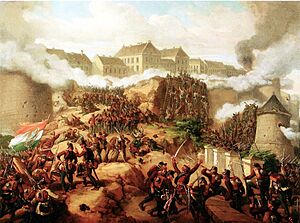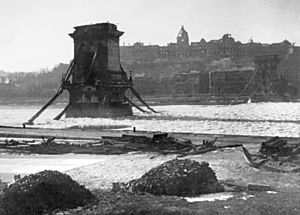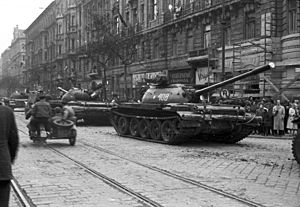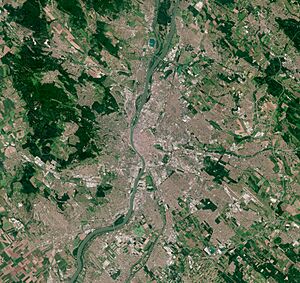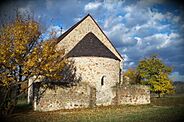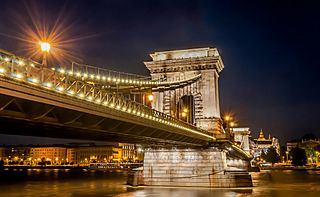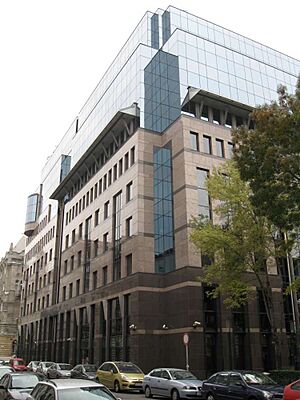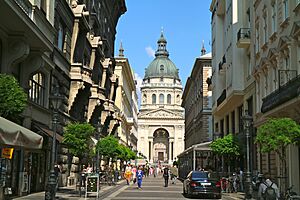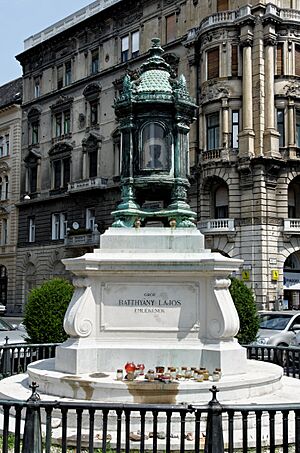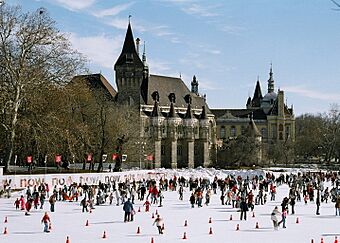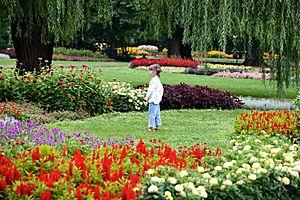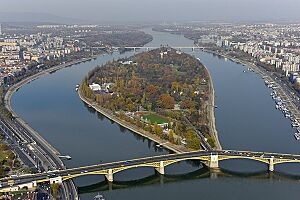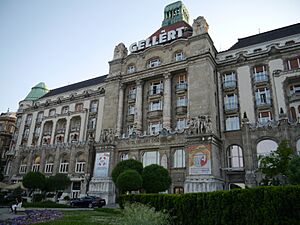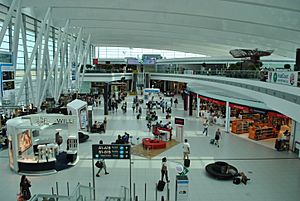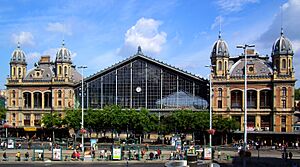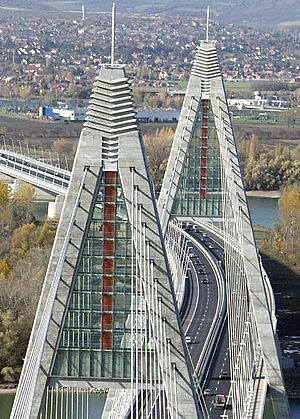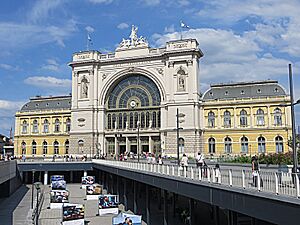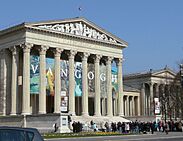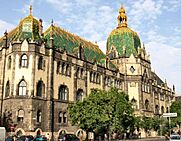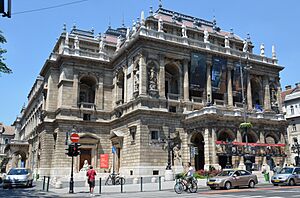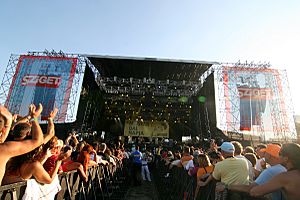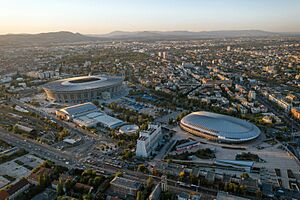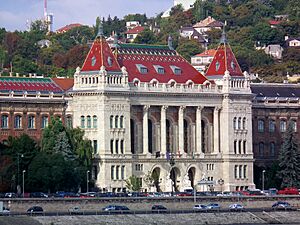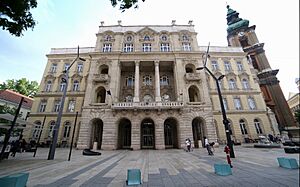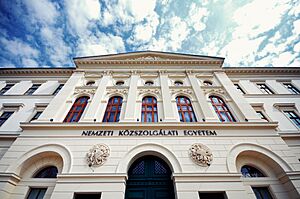Budapest facts for kids
Quick facts for kids
Budapest
|
|||||||||||||||||
|---|---|---|---|---|---|---|---|---|---|---|---|---|---|---|---|---|---|
|
Capital city and municipality
|
|||||||||||||||||
| Capital City of Hungary Magyarország fővárosa |
|||||||||||||||||
|
Buda Castle and the Chain Bridge
Heroes' Square
Fisherman's Bastion with Matthias Church
Gellért Baths and the Liberty Bridge
|
|||||||||||||||||
|
|||||||||||||||||
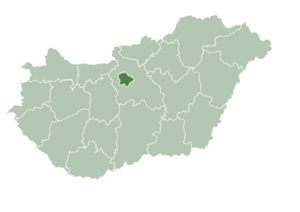
Budapest highlighted in Hungary
|
|||||||||||||||||
| Country | |||||||||||||||||
| Region | Central Hungary | ||||||||||||||||
| Unification of Buda, Pest and Óbuda | 17 November 1873 | ||||||||||||||||
| Boroughs |
23 districts
I., Várkerület
II. III., Óbuda-Békásmegyer IV., Újpest V., Belváros-Lipótváros VI., Terézváros VII., Erzsébetváros VIII., Józsefváros IX., Ferencváros X., Kőbánya XI., Újbuda XII., Hegyvidék XIII. XIV., Zugló XV., Rákospalota, Pestújhely, Újpalota XVI. XVII., Rákosmente XVIII., Pestszentlőrinc-Pestszentimre XIX., Kispest XX., Pesterzsébet XXI., Csepel XXII., Budafok-Tétény XXIII., Soroksár |
||||||||||||||||
| Government | |||||||||||||||||
| • Type | Mayor – Council | ||||||||||||||||
| • Body | General Assembly of Budapest | ||||||||||||||||
| Area | |||||||||||||||||
| • Capital city and municipality | 525.2 km2 (202.8 sq mi) | ||||||||||||||||
| • Urban | 2,538 km2 (980 sq mi) | ||||||||||||||||
| • Metro | 6,917 km2 (2,671 sq mi) | ||||||||||||||||
| Elevation | Lowest (Danube) 96 m Highest (János Hill) 527 m (315 to 1,729 ft) |
||||||||||||||||
| Population
(2022 census)
|
|||||||||||||||||
| • Capital city and municipality | 1,685,342 | ||||||||||||||||
| • Estimate
(January 2023)
|
1,671,004 | ||||||||||||||||
| • Rank | 1st (9th in EU) | ||||||||||||||||
| • Density | 3,182/km2 (8,240/sq mi) | ||||||||||||||||
| • Metro | 2,999,794 | ||||||||||||||||
| • Metro density | 434/km2 (1,120/sq mi) | ||||||||||||||||
| Demonyms | Budapester, budapesti (Hungarian) | ||||||||||||||||
| GDP Nominal (2022) | |||||||||||||||||
| • Capital city and municipality | €62 billion (36.7% of Hungary) | ||||||||||||||||
| • Metro | €82 billion (48.5% of Hungary) | ||||||||||||||||
| • Per capita (City) | €36,276 | ||||||||||||||||
| Time zone | UTC+1 (CET) | ||||||||||||||||
| • Summer (DST) | UTC+2 (CEST) | ||||||||||||||||
| Postal code(s) |
1011–1239
|
||||||||||||||||
| Area code | 1 | ||||||||||||||||
| ISO 3166 code | HU-BU | ||||||||||||||||
| NUTS code | HU101 | ||||||||||||||||
| HDI (2018) | 0.901 – very high · 1st | ||||||||||||||||
| International Airport | Ferenc Liszt International Airport | ||||||||||||||||
| Website | |||||||||||||||||
|
|||||||||||||||||
Budapest is the capital and largest city of Hungary. It is also the ninth-largest city in the European Union by population. Budapest is located along the Danube river, which makes it the second-largest city on this important waterway. The city covers about 525 square kilometers and has an estimated population of 1.75 million people.
Budapest is more than just a city; it is also a municipality. It forms the center of the Budapest metropolitan area, which is much larger, covering about 7,626 square kilometers and home to over 3.3 million people. This means that about 33% of Hungary's population lives in or around Budapest.
The history of Budapest began with a Celtic settlement that later became Roman town of Aquincum. This was the capital of Lower Pannonia. Hungarians arrived in the late 800s. However, the area was attacked by the Mongols in 1241–42. After this, Buda was rebuilt and became a center for Renaissance culture by the 1400s.
The Battle of Mohács in 1526 led to nearly 150 years of Ottoman rule. After Buda was taken back in 1686, the region became prosperous again. The cities of Buda, Óbuda, and Pest officially joined together on November 17, 1873, forming the new capital named 'Budapest'. It also became a co-capital of the Austro-Hungarian Empire. This empire broke apart after World War I in 1918. Budapest was also a key location for the Hungarian Revolution of 1848 and the 1956 Hungarian Revolution.
Today, Budapest is a global city. It is strong in business, finance, media, art, and technology. It is Hungary's financial centre and home to important European offices like the European Institute of Innovation and Technology. Over 40 colleges and universities are in Budapest. The city's subway system, the Budapest Metro, opened in 1896 and serves many passengers daily. The Budapest Tram Network is also very busy.
The central part of Budapest along the Danube River is a UNESCO World Heritage Site. It has many famous buildings, including the Hungarian Parliament and the Buda Castle. The city also has about 80 geothermal springs, the largest thermal water cave system, the second-largest synagogue, and the third-largest Parliament building in the world. Budapest attracts about 12 million international tourists each year, making it a very popular place to visit in Europe.
Contents
- Understanding the Name Budapest
- Budapest's Journey Through Time
- Budapest's Landscape and Weather
- Amazing Buildings and Styles
- City Districts
- Who Lives in Budapest?
- Budapest's Economy and Business
- Top Sights and Fun in Budapest
- Getting Around Budapest
- Culture and Daily Life
- Sports and Recreation
- Learning in Budapest
- Budapest's Global Connections
- Images for kids
- See also
Understanding the Name Budapest
The cities of Buda, Óbuda, and Pest officially joined in 1873 to form the new name Budapest. Before this, people sometimes called the towns "Pest-Buda." Today, "Pest" is often used to mean the whole city in everyday talk, but it really refers to the parts of the city east of the Danube River. "Buda" means all the areas west of the Danube, including the old Óbuda. The islands in the Danube, like Csepel, are not part of either Buda or Pest.
In English, the "s" in "Budapest" sounds like the "s" in "pest." The "u" in "Buda-" can sound like "oo" in "food" or "yoo" in "cue." In Hungarian, the "s" sounds like "sh" in "wash."
The names "Buda" and "Pest" have unclear beginnings. "Buda" might come from the name of an early fortress leader or a Turkish or Slavic personal name. A legend says "Buda" comes from Bleda, the brother of the Hunnic ruler Attila.
There are a few ideas about where "Pest" came from. One idea is that it comes from Roman times, from a fortress called "Pession." Another idea is that it comes from a Slavic word for "cave." A third idea suggests it refers to a cave where fires burned.
Budapest's Journey Through Time
Early Settlements and Kingdoms
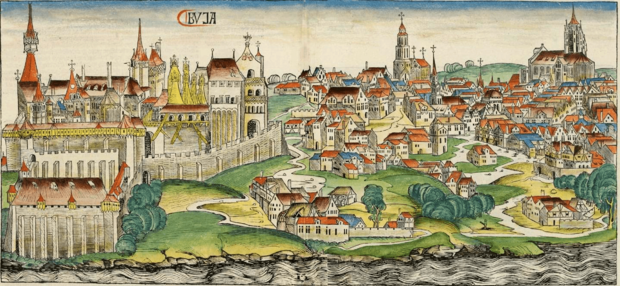
The first settlement in the Budapest area was built by the Celts before 1 AD. Later, the Romans took over. Their settlement, Aquincum, became an important city in the Roman province of Pannonia Inferior in 106 AD. It started as a military camp and grew into a busy city. Today, this area is the Óbuda district. The Romans built roads, amphitheaters, baths, and houses with heated floors. Aquincum is the best-preserved Roman site in Hungary. You can visit its museum with indoor and outdoor sections.
The Magyar tribes, led by Árpád, settled here in the late 800s. They officially founded the Kingdom of Hungary a century later. In the 1200s, the Mongols invaded, showing that the flat land was hard to defend. So, King Béla IV of Hungary ordered stone walls to be built around the towns. He also placed his royal palace on the hills of Buda. In 1361, Buda became the capital of Hungary.
Buda became very important for culture during the rule of King Matthias Corvinus. The Italian Renaissance greatly influenced the city. His library, the Bibliotheca Corviniana, was one of Europe's largest collections of books in the 1400s. The first Hungarian university was founded in Pécs in 1367, and the second in Óbuda in 1395. The first Hungarian book was printed in Buda in 1473. Around 1500, Buda had about 5,000 people.
The Ottomans conquered Buda in 1526 and again in 1541. Their rule lasted for over 150 years. The Ottoman Turks built many famous bathing places in the city. Some of these baths, like Rudas Baths and Király Baths, are still used today, 500 years later. By 1547, the number of Christians in Buda had dropped to about a thousand, and by 1647, to only about seventy. The western part of Hungary that was not occupied by the Ottomans became part of the Habsburg monarchy.
In 1686, a large army called the Holy League took Buda back from the Ottomans. This army had over 74,000 soldiers from many European countries. In the following years, almost all Hungarian lands were taken back from the Turks. The 1699 Treaty of Karlowitz officially ended Turkish rule.
Modern History and Growth
The 1800s were a time of struggle for Hungarian independence and modernization. The national uprising against the Habsburgs started in Budapest in 1848 but was defeated later with help from the Russian Empire. In 1867, the Reconciliation created Austria-Hungary, making Budapest a co-capital of this dual monarchy. This led to a big period of growth for Budapest until World War I.
In 1849, the Chain Bridge opened, connecting Buda and Pest. It was the first permanent bridge across the Danube. In 1873, Buda and Pest officially merged with Óbuda, creating the new city of Budapest. The Pest side grew into the country's main center for government, economy, trade, and culture. Many Hungarians moved to the city, and Hungarian became the main language. Budapest was sometimes called the "Jewish Mecca" because of its large Jewish community.
In 1918, Austria-Hungary lost World War I and broke apart. Hungary became an independent republic. The 1920 Treaty of Trianon greatly reduced Hungary's territory.
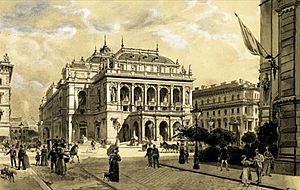
In 1944, during World War II, Budapest was partly damaged by air raids. From December 1944 to February 1945, the city was under siege during the Battle of Budapest. The city suffered major damage, and all its bridges were destroyed. Sadly, many civilians died during this conflict.
During the German occupation of Hungary in 1944-1945, many Jewish people in Budapest were persecuted. Brave diplomats like Carl Lutz from Switzerland, Raoul Wallenberg from Sweden, and Giorgio Perlasca from Italy helped save tens of thousands of Jewish lives by providing protection papers and safe houses.
After World War II, the Red Army took control of Hungary, and the country became a communist People's Republic in 1949. Many historic buildings, like the Buda Castle, were damaged or changed by the new government.
On October 23, 1956, people in Budapest held a peaceful protest asking for democratic changes. When troops were ordered to shoot at the crowd, Hungarian soldiers joined the protesters. This started the Hungarian Revolution of 1956. The uprising was against Soviet influence and lasted until November 11. Soviet tanks entered the country to stop the revolt, and over 3,000 people died. A monument was built in 2006 to remember this event.
From the 1960s to the late 1980s, much of the wartime damage was fixed. The last bridge, Erzsébet Bridge, was rebuilt in 1964. The Budapest Metro expanded with new lines. In 1987, Buda Castle and the Danube banks became UNESCO World Heritage Sites. Andrássy Avenue and its surroundings were added to the UNESCO list in 2002. In the 1980s, the city's population reached 2.1 million. Recently, the population has decreased as people move to the suburbs.
After the fall of communism in 1989–90, monuments from the old government were moved to Memento Park. In 2019, Gergely Karácsony, an opposition candidate, became the mayor of Budapest.
Budapest's Landscape and Weather
City Layout and Natural Features
Budapest is located in the center of the Pannonian Basin. It sits on an old route that connects the hills of Transdanubia with the Great Plain. The city covers 525 square kilometers in Central Hungary. It stretches about 25 kilometers north to south and 29 kilometers east to west.
The Danube River flows through the city from the north. It goes around two islands, Óbuda Island and Margaret Island. The largest island, Csepel Island, is mostly outside the city limits, but its northern tip is within Budapest. The river, which divides the city, is about 230 meters wide at its narrowest point in Budapest.
Budapest has different types of land. Buda is built on the higher hills on the western side. The much larger Pest spreads out on a flat, sandy plain on the eastern side of the river. Pest's land gently slopes upwards to the east. So, the easternmost parts of the city are as high as Buda's smaller hills, like Gellért Hill and Castle Hill.
The Buda hills are mostly made of limestone and dolomite. Water has created amazing speleothems (cave formations) there. The most famous caves are the Pálvölgyi cave (7,200 meters long) and the Szemlőhegyi cave (2,200 meters long). These hills formed during the Triassic Period. The highest point in the hills and in Budapest is János Hill, which is 527 meters above sea level. The lowest point is the Danube River, at 96 meters above sea level.
Budapest has many green areas. About 83 square kilometers of the city's total area are parks, forests, and other green spaces. The forests in the Buda hills are protected.
Budapest is a very important transport hub. Many major European roads and European railway lines lead to the city. The Danube has always been a key waterway. This area in the center of the Carpathian Basin is at a crossroads of trade routes.
Budapest is one of only three capital cities in the world with thermal springs. The others are Reykjavík in Iceland and Sofia in Bulgaria. About 125 springs produce 70 million liters of thermal water daily, with temperatures up to 58 Celsius. Some people believe these waters have healing effects because of their high mineral content.
Budapest's Climate
Budapest has a climate that mixes humid temperate and humid continental weather. This means it has warm to hot summers and chilly winters. Winter (November to early March) can be cold with little sunshine. Snow often falls, and nighttime temperatures can drop to -10 Celsius between mid-December and mid-February.
Spring (March and April) has changing weather, but temperatures quickly rise. Late March and April days are often pleasant, with cool nights. Budapest's long summer, from May to mid-September, is warm or very warm. Sudden heavy rain showers can happen, especially in May and June. Autumn (mid-September to late October) usually has little rain, long sunny days, and mild temperatures. Temperatures often get much colder in late October or early November.
On average, Budapest gets about 23.5 inches of rain each year. There are usually 84 days with rain and 1988 hours of sunshine annually.
Amazing Buildings and Styles
Budapest has many interesting buildings from different time periods and in various styles. These range from the ancient Roman city of Aquincum, built around 89 AD, to the modern Palace of Arts, which is a contemporary art museum and concert hall.
Most buildings in Budapest are not very tall. In the early 2010s, there were only about 100 buildings taller than 45 meters. Building rules keep the number of tall buildings low to protect the historic look of the city and its World Heritage Site status. There are strict rules for planning and building tall structures, so you won't find many skyscrapers in the inner city.
Budapest's architecture covers a long timeline. It starts with the Roman city of Aquincum, showing ancient architecture.
The next important style is Gothic architecture. A few Gothic buildings remain in the Castle District. For example, numbers 18, 20, and 22 on Országház Street date back to the 1300s. No. 31 Úri Street has a Gothic front from the 1400s. Other buildings with Gothic features include the Inner City Parish Church, built in the 1100s, and the Mary Magdalene Church, finished in the 1400s. The most famous Gothic-style buildings, like the Hungarian Parliament Building and the Matthias Church, are actually Neo-Gothic. They were built later but used some original materials.
Renaissance architecture came to Hungary early. It appeared after King Matthias Corvinus married Beatrice of Naples in 1476, bringing many Italian artists and builders to Buda. Many original Renaissance buildings are gone now, but Budapest still has many Renaissance and Neo-Renaissance buildings. Famous examples include the Hungarian State Opera House, St. Stephen's Basilica, and the Hungarian Academy of Sciences.
During the Turkish rule (1541–1686), Ottoman architecture flourished in Budapest. Many mosques and baths were built. These buildings showed influences from Turkish, Iranian, Arabian, and Byzantine architecture. After the city was taken back, most mosques were replaced with churches. However, some original Turkish bathhouses from the 1500s, like Rudas Baths and Király Baths, are still used today. Budapest is also home to the northernmost tomb of an important Islamic Sufi Dervish, Gül Baba.
After 1686, Baroque architecture became popular. Budapest has many Baroque buildings. A great example is the Church of St. Anna in Batthyhány Square. Óbuda also has beautiful historic buildings with Baroque fronts. The Castle District, including the famous Buda Royal Palace, also has many Baroque-style buildings.
Next came Classical architecture and Neoclassical architecture. Two architects, Mihály Pollack and József Hild, built many beautiful Classicist buildings in Budapest. Some of the best examples are the Hungarian National Museum and the Sándor Palace, which is the Hungarian president's office. The most iconic Classicist building is the Széchenyi Chain Bridge.
Budapest's two most beautiful Romantic architecture buildings are the Great Synagogue and the Vigadó Concert Hall. The Budapest Western Railway Station was designed by August de Serres and built by the Eiffel Company in 1877.
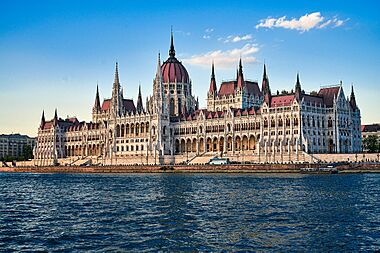
Art Nouveau became popular in Budapest around 1896 during the Hungarian Millennium celebrations. Hungarian Art Nouveau, called Szecesszió, mixes different styles with a focus on Hungarian traditions. Ödön Lechner, a leading Art Nouveau architect, was inspired by Indian and Syrian architecture. One of his most beautiful buildings is the Museum of Applied Arts. Other Art Nouveau examples include the Gresham Palace, the Hotel Gellért, the Franz Liszt Academy of Music, and the Budapest Zoo and Botanical Garden.
In the second half of the 1900s, under the communist government, many blocks of flats were built. In the 21st century, Budapest faces new challenges in architecture. While there is pressure to build taller buildings, the city wants to keep its unique historic look and green areas. Contemporary architecture is also growing in the city. Many public spaces have been renovated, like Kossuth Lajos Square and Liberty Square. New landmarks include the National Theatre and the Palace of Arts.
City Districts
|
|
||||
| Administration | Population | Area and Density | ||
| District | Official name | Official 2013 | Km2 | People/km2 |
| I | Várkerület | 24.528 | 3,41 | 7.233 |
| II | Rózsadomb | 88.011 | 36,34 | 2.426 |
| III | Óbuda-Békásmegyer | 123.889 | 39,69 | 3.117 |
| IV | Újpest | 99.050 | 18,82 | 5.227 |
| V | Belváros-Lipótváros | 27.342 | 2,59 | 10.534 |
| VI | Terézváros | 43.377 | 2,38 | 18.226 |
| VII | Erzsébetváros | 64.767 | 2,09 | 30.989 |
| VIII | Józsefváros | 85.173 | 6,85 | 11.890 |
| IX | Ferencváros | 63.697 | 12,53 | 4.859 |
| X | Kőbánya | 81.475 | 32,5 | 2.414 |
| XI | Újbuda | 145.510 | 33,47 | 4.313 |
| XII | Hegyvidék | 55.776 | 26,67 | 2.109 |
| XIII | Angyalföld, Göncz Árpád városközpont, Újlipótváros, Vizafogó |
118.320 | 13,44 | 8.804 |
| XIV | Zugló | 123.786 | 18,15 | 6.820 |
| XV | Rákospalota, Pestújhely, Újpalota | 79.779 | 26,95 | 2.988 |
| XVI | Árpádföld, Cinkota, Mátyásföld, Sashalom, Rákosszentmihály |
68.235 | 33,52 | 2.037 |
| XVII | Rákosmente | 78.537 | 54.83 | 1.418 |
| XVIII | Pestszentlőrinc-Pestszentimre | 94.663 | 38,61 | 2.414 |
| XIX | Kispest | 62.210 | 9,38 | 6.551 |
| XX | Pesterzsébet | 63.887 | 12,18 | 5.198 |
| XXI | Csepel | 76.976 | 25,75 | 2.963 |
| XXII | Budafok-Tétény | 51.071 | 34,25 | 1.473 |
| XXIII | Soroksár | 19.982 | 40,78 | 501 |
|
|
1,740,041 | 525.2 | 3,313.1 | |
|
|
9,937,628 | 93,030 | 107.2 | |
| Source: Eurostat, HSCO | ||||
Budapest is divided into 23 districts. Each district has its own mayor and local government. These local governments have specific responsibilities that do not overlap with the main city government. Each district also has a recognized name, some of which are common local names for neighborhoods.
When Buda, Pest, and Óbuda joined in 1873, Budapest first had 10 districts. In 1950, to help with social and industrial plans, 7 cities and 16 towns were added to the capital. This created what is now called Greater Budapest, with 22 districts. In 1994, Soroksár separated from Pesterzsébet, making it 23 districts. Today, 6 districts are in Buda, 16 in Pest, and one is Csepel. The city center generally includes districts I, II, XI, XII in Buda and V, VI, VII, VIII, IX in Pest.
Budapest's districts are numbered in a pattern of semicircles. District I is a small area in central Buda, including the Castle Quarter. District II is northwest of the castle in Buda, and District III stretches along northern Buda. District IV continues this semicircle in northern Pest. District V is in the very center of Pest and starts a new circle that goes through Pest back to Buda. The outer districts form another semicircle in Pest.
Who Lives in Budapest?
|
|
|||
| Budapest | Hungary | European Union | |
| Total Population | 1,763,913 | 9,937,628 | 507,890,191 |
| Population change, 2004 to 2014 | +2.7% | −1.6% | +2.2% |
| Population density | 3,314 /km2 | 107 /km2 | 116 /km2 |
| GDP per capita PPP | $52,770 | $33,408 | $33,084 |
| Bachelor's Degree or higher | 34.1% | 19.0% | 27.1% |
| Foreign born | 7.3% | 1.7% | 6.3% |
| Historical population | ||
|---|---|---|
| Year | Pop. | ±% |
| 1784 | 57,100 | — |
| 1850 | 206,339 | +261.4% |
| 1870 | 302,086 | +46.4% |
| 1880 | 402,706 | +33.3% |
| 1890 | 560,079 | +39.1% |
| 1900 | 861,434 | +53.8% |
| 1910 | 1,110,453 | +28.9% |
| 1920 | 1,232,026 | +10.9% |
| 1930 | 1,442,869 | +17.1% |
| 1941 | 1,712,791 | +18.7% |
| 1949 | 1,590,316 | −7.2% |
| 1955 | 1,713,552 | +7.7% |
| 1960 | 1,804,606 | +5.3% |
| 1965 | 1,877,916 | +4.1% |
| 1970 | 1,945,083 | +3.6% |
| 1980 | 2,059,226 | +5.9% |
| 1990 | 2,005,028 | −2.6% |
| 2001 | 1,773,401 | −11.6% |
| 2011 | 1,729,040 | −2.5% |
| 2022 | 1,682,426 | −2.7% |
| 1784, Population 2001 to 2019 Present-territory of Budapest Population size may be affected by changes in administrative divisions. |
||
Budapest is the most populous city in Hungary and one of the largest cities in the European Union. Its population is growing, with about 1,763,913 people in 2019, as more people move in than move out. The larger Budapest metropolitan area is home to 3.3 million people, which is about 34% of Hungary's total population. In 2014, Budapest had a population density of 3,314 people per square kilometer, making it the most densely populated city in Hungary. One district, Elisabethtown-District VII, has one of the highest population densities in the world.
Budapest is seen as one of Europe's fastest-growing cities by population. Experts predict its population will increase by almost 10% between 2005 and 2030, mainly due to people moving there. This growth has helped household incomes in Budapest rise more than in other parts of Hungary.
According to a 2016 survey, there were 1,764,263 people living in Budapest. During working hours or special events, about 1.6 million people from the wider metropolitan area might be in the city. This is because many suburban residents travel to Budapest for work, school, healthcare, and events.
Most people in Budapest are Hungarians (96.2%). There are also smaller groups of Germans, Romani, Romanians, and Slovaks. The share of ethnic Hungarians is a bit lower than the national average because of people moving to Budapest from other countries.
In 2011, almost everyone (99.0%) in Budapest spoke Hungarian. Many people also spoke other languages, like English (31.0%), German (15.4%), French (3.3%), and Russian (3.2%).
Most people (92.6%) were born in Hungary, but 7.3% were born outside Hungary. In 2009, 43% of all foreigners living in Hungary lived in Budapest, making up 4.4% of the city's population. Many younger foreigners move to Hungary for work.
Religion in Budapest (2022 census – of those who declared their religion (55.5%) Roman Catholic (40.7%) Calvinistic (13.6%) Lutheran (2.8%) Greek Catholic (1.8%) Orthodox (0.5%) Other Christian denomination (4.2%) Jewish (0.5%) Other religion (1.3%) Not religious (34.6%)
Budapest has a large Christian community, with 698,521 people (40.4%) in 2011. Most Christians are Roman Catholics (29.0%) or Calvinists (8.5%). The city also has one of Europe's largest Jewish communities. Many people (22.9%) said they had no religion, and 33.9% did not state their religion.
Budapest's Economy and Business
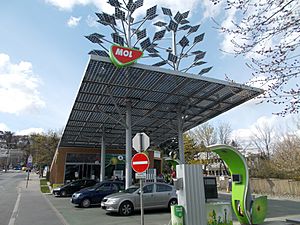
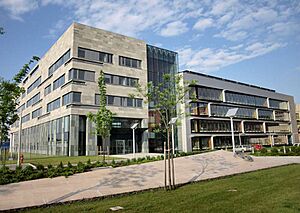
Budapest is a very important economic center. It is considered a "Beta +" world city, meaning it plays a significant role in the global economy. It is the second fastest-growing urban economy in Europe. In 2014, the city's GDP per person grew by 2.4%, and employment increased by 4.7%.
At a national level, Budapest is Hungary's main city for business and the economy. It accounts for 39% of the country's income. In 2015, the city's total economic output (gross metropolitan product) was over $100 billion, making it one of the largest regional economies in the European Union.
According to Eurostat, the GDP per person in Budapest is 147% of the EU average, which is about €37,632 ($42,770). Budapest is also among the Top 100 cities in the world for GDP, according to PricewaterhouseCoopers. It was ranked the 52nd most important business center globally.
The city is a major hub for banking, finance, real estate, trade, tourism, and technology in Hungary and the region. Budapest is home to almost all national institutions and many Hungarian and international companies. In 2014, there were 395,804 companies registered in the city. Most of these companies have their main offices in Budapest's central business area. The city's retail market is also concentrated downtown, with large shopping centers like WestEnd City Center and Arena Plaza.
Budapest is known for its innovation as a technology and start-up hub. Many new companies start their business here, such as Prezi, LogMeIn, and NNG. Budapest is the top-ranked city in Central and Eastern Europe for innovation. The European Institute of Innovation and Technology chose Budapest for its headquarters. The city's research activities are also global, with the European Chinese Research Institute located here. Other important areas include science research, information technology, and medical research. The unemployment rate in Budapest is very low compared to the rest of Hungary.
Budapest is among the 25 most visited cities in the world, attracting over 4.4 million international tourists each year. Tourism greatly helps the city's economy. The capital has many convention centers and thousands of restaurants, bars, and hotels. Some restaurants even have Michelin stars. In 2010, Budapest was ranked the most livable city in Central and Eastern Europe.
Finance and Major Companies
The Budapest Stock Exchange is a key financial institution in Hungary and Central and Eastern Europe. It is located in Budapest's central business district. The exchange trades stocks, government bonds, and other financial products. Many large Hungarian companies based in Budapest are listed on the stock exchange, such as MOL Group, OTP Bank, and Gedeon Richter.
Almost all types of industries can be found in Budapest today. The city is a strong financial centre, with nearly 40 major banks, including international ones like Citigroup and Deutsche Bank.
Another strong industry in Budapest is biotechnology and pharmaceuticals. There are traditional Hungarian companies like Egis and Gedeon Richter, as well as international companies like Pfizer and Novartis, which have research and production facilities here.
High-tech industries, like software development and engineering, are also important. Companies such as Nokia, Ericsson, Bosch, and Microsoft employ thousands of engineers in research and development in Budapest. Game design is also well-represented with companies like Digital Reality and studios for Crytek and Gameloft.
Many global companies have regional headquarters in Budapest, including General Motors, General Electric, and IBM.
Top Sights and Fun in Budapest
Budapest is famous for its beautiful pre-war cityscape, with many streets and landmarks in classical architecture.
The most famous sight is the neo-Gothic Parliament. It is the biggest building in Hungary, 268 meters long. It also holds the Hungarian Crown Jewels.
Saint Stephen's Basilica is the city's most important religious building. It displays the Holy Right Hand of Hungary's first king, Saint Stephen.
You can experience Hungarian cuisine and café culture in many places. Famous spots include Gerbeaud Café and the world-famous Gundel restaurant.
You can find Roman ruins at the Aquincum Museum and historic furniture at the Nagytétény Castle Museum. These are just two of Budapest's 223 museums. Another historical museum is the House of Terror, located in a building that was once a Nazi headquarters. The Castle Hill, the Danube River banks, and Andrássy út are all officially recognized as UNESCO World Heritage Sites.
The Castle Hill and the Castle District have three churches, six museums, and many interesting buildings. The former Royal Palace is a symbol of Hungary and has seen many battles since the 1200s. Today, it houses two museums and the National Széchenyi Library. The nearby Sándor Palace is where the President of Hungary works and lives. The 700-year-old Matthias Church is a beautiful building in neo-Gothic style, with colorful roof tiles. Next to it is a statue of King Saint Stephen. Behind that is the Fisherman's Bastion, built in 1905, which offers amazing views of the city. Statues of the Turul, Hungary's mythical guardian bird, can be found in the Castle District.
In Pest, Andrássy út is a very important sight. This elegant, 2.5-kilometer-long tree-lined street goes from Deák Ferenc tér to Heroes' Square. It is a UNESCO World Heritage Site. Underneath it runs continental Europe's oldest Underground railway. Heroes' Square is dominated by the Millenary Monument. On its sides are the Museum of Fine Arts and the Kunsthalle Budapest. Behind it is the City Park with Vajdahunyad Castle. The Hungarian State Opera House is another beautiful building on Andrássy út. Statue Park, with statues from the Communist era, is just outside the city.
The Dohány Street Synagogue is the largest synagogue in Europe and the second largest active synagogue in the world. It is in the Jewish district in central Budapest. Built in 1859 in a Moorish revival style, it can seat 3,000 people. Next to it is a sculpture of a weeping willow tree made of steel, remembering the Hungarian victims of the Holocaust.
The city also has Europe's largest medicinal bath (Széchenyi Medicinal Bath) and the world's third-largest Parliament building. The bridges of the capital are also attractions. Seven bridges cross the Danube. The most beautiful are the Margaret Bridge, the Chain Bridge, and the Liberty Bridge.
Tourists can get free maps and information from the Budapest Festival and Tourism Center. They also offer the Budapest Card, which gives free public transport and discounts for museums and restaurants. The city is also known for its "ruin bars."
Famous Squares to Explore
Budapest has many squares. The most important ones are Heroes' Square, Kossuth Square, Liberty Square, St. Stephen's Square, Ferenc Deák Square, Vörösmarty Square, Erzsébet Square, St. George's Square, and Széchenyi István Square.
Heroes' Square, at the end of Andrássy Avenue, is the largest and most important square. It features the Millennium Monument, the Museum of Fine Arts, and The Hall of Art.
Kossuth Square is a symbolic place for the Hungarian state. Here you'll find the Hungarian Parliament Building, the Palace of Justice, and the Ministry of Agriculture.
Liberty Square is one of Budapest's most beautiful squares in the Inner City District. It has buildings like the Hungarian National Bank and the U.S. Embassy. It also has statues and monuments, including the Soviet War Memorial and a statue of Ronald Reagan.
St. Stephen's Square is home to the St. Stephen's Basilica. A walking street, Zrínyi Street, connects it to Széchenyi István Square at the foot of the Chain Bridge. The Hungarian Academy of Sciences and the Gresham Palace are also here.
Deák Ferenc Square is a central transport hub where three Budapest subway lines meet. It also has the oldest and most famous Evangelical Church in Budapest.
Vörösmarty Square is in the Inner City District, behind the Vigadó of Pest. It is one end of Váci Street. The Gerbeaud Confectionery is here, and an annual Christmas Fair is held in the square.
Parks and Green Spaces
Budapest has many municipal parks, most with playgrounds and seasonal activities like ice skating in winter and boating in summer. It's easy to get to them from the city center using the Millennium Underground. The city has a large park system managed by Budapest City Gardening Ltd.
Beyond the parks, Budapest has many open spaces with forests, streams, and lakes. These natural areas are close to the inner city and include the Budapest Zoo and Botanical Garden, founded in 1866 in the City Park.
The most popular parks are the City Park (established in 1751), Margaret Island in the Danube, the People's Park, the Római Part, and the Kopaszi Dam.
The Buda Hills offer many outdoor activities and great views. Normafa is a popular spot for locals, with activities for all seasons, including a small ski run in winter.
Islands in the Danube
Several islands are found on the Danube River in Budapest:
- Margaret Island is 2.5 kilometers long and 0.965 square kilometers in area. It is mostly a park and a popular place for both tourists and locals to relax and play sports. The island is between Margaret Bridge and Árpád Bridge. You can find dance clubs, swimming pools, an aqua park, and tracks for running and biking.
- Csepel Island is the largest island in the Danube in Hungary. It is 48 kilometers long, but only its northern tip is within Budapest city limits.
- Hajógyári Island, also known as Óbuda Island, is a human-made island in the third district. It hosts activities like wake-boarding and jet-skiing during the day, and dance clubs at night. This is also where the famous Sziget Festival takes place, with hundreds of performances and attracting about 400,000 visitors each year. Plans are underway to make this island one of Europe's biggest entertainment centers.
The islands of Palotai Island, Nép Island, and Háros Island used to be in the city but are now connected to the mainland.
The Ínség Rock is a reef in the Danube near Gellért Hill. It only appears during dry periods when the river level is very low.
Just north of the city are the large Szentendre Island and the smaller Lupa Island.
Relaxing Thermal Spas
The Romans first settled west of the Danube to use the thermal springs. You can still see ruins of the huge baths they built. The new baths built during the Turkish period (1541–1686) were for both bathing and medicine, and some are still used today.
Budapest became known as a "City of Spas" in the 1920s. In 1934, it was officially given this title. Today, the baths are mostly popular with older people, while younger people often prefer the outdoor pools open in summer.
Construction of the Király Baths began in 1565. Most of the building today dates from the Turkish period, including its beautiful dome-topped pool.
The Rudas Baths are in the city center, between Gellért Hill and the Danube. They are a great example of Turkish architecture. The main feature is an octagonal pool lit by light from a 10-meter-wide dome.
The Gellért Baths and Hotel were built in 1918. They were expanded in 1927 to include a wave pool and in 1934 with an effervescent bath. The well-preserved Art Nouveau interior has colorful mosaics, marble columns, and stained glass.
The Lukács Baths are also in Buda and have Turkish origins. They were revived in the late 1800s when the spa and treatment center were founded. Since the 1950s, it has been a popular spot for thinkers and artists.
The Széchenyi Baths are one of Europe's largest bathing complexes and the only "old" medicinal baths on the Pest side. The indoor baths opened in 1913, and the outdoor pools in 1927. The place has a grand feel, with large pools like Roman baths and smaller tubs like Greek baths. The saunas and diving pools are inspired by northern European traditions. The three outdoor pools are open all year, even in winter. Inside, there are over ten separate pools and many medical treatments. The Széchenyi Baths are built in a modern Renaissance style.
Getting Around Budapest
Airport Connections
Budapest is served by Budapest Ferenc Liszt International Airport (BUD), named after the famous Hungarian composer Franz Liszt. It is one of the busiest airports in Central and Eastern Europe. The airport is 16 kilometers southeast of Budapest's center.
The airport connects Budapest to major cities across Europe, North America, Africa, Asia, and the Middle East. It handles almost all of Hungary's air passenger traffic. In 2013, Budapest Liszt Ferenc managed about 250 scheduled flights daily. London, Brussels, Frankfurt, Munich, Paris, and Amsterdam are some of the busiest international connections.
The airport is a base for airlines like Ryanair and Wizz Air. You can reach the airport from the city center by taking Metro line 3 and then bus No. 200E.
The airport has undergone major improvements and modernization, with €561 million spent by December 2012. The SkyCourt, a modern building between terminals 2A and 2B, has five levels. It includes passenger security checks, baggage systems, and business lounges.
Public Transport System
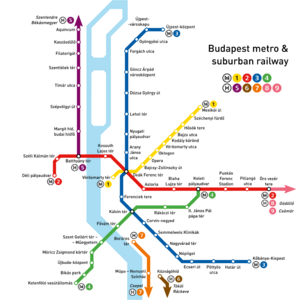

Public transport in Budapest is managed by the Centre for Budapest Transport (BKK). BKK is one of Europe's largest transport authorities. It operates:
- 4 metro lines (including the historic Line 1, the oldest underground railway in continental Europe)
- 5 suburban railway lines
- 33 tram lines
- 15 trolleybus lines
- 264 bus lines (including 40 night routes)
- 4 boat services
- BuBi, a bicycle sharing network
On an average weekday, BKK lines carry 3.9 million passengers. In 2011, they handled a total of 1.4 billion passengers. In 2014, 65% of passenger traffic in Budapest used public transport, and 35% used cars. The goal is to reach 80% public transport use by 2030.
People aged 65 and over, and children under 14, travel for free.
Budapest is developing a smart transportation system. Smart traffic lights are common; they use GPS to give priority to public transport vehicles. Traffic is measured, and drivers get real-time information about travel times. Public transport users are instantly updated on changes online, on smartphones, and on displays. Car drivers can also track traffic changes in real-time. All public transport vehicles can be followed online using the Futár system.
The Futár system, a citywide real-time passenger information system and route planner, is complete. All public transport vehicles are connected by satellite. Real-time information for trams, buses, and trolleybuses is available to operators and passengers at stops, on smartphones, and on city displays. An e-ticket system with NFC compatibility and contactless smart cards is also being introduced.
Tram lines 4 and 6 are among the busiest in the world. They use some of the world's longest trams (54-meter Siemens Combino) every 2–3 minutes during peak times. Day services usually run from 4 AM until late at night. Hungarian State Railways operates many commuter rail services, which are important for suburban travel.
The Centre for Budapest Transport (BKK) plans and organizes all public transport in the city. This includes setting fares, managing contracts, customer service, selling tickets, providing passenger information, and controlling traffic. They also manage roads, taxi stations, bicycle development, parking, and road reconstruction.
Roads and Railways
Budapest is Hungary's most important road and railway hub. All major highways and railways end within the city. The city's road system is like Paris, with several ring roads and avenues spreading out from the center. The Ring road M0 around Budapest is almost finished. Once complete, it will be 107 kilometers long.
The city is a vital traffic hub because all major European roads and railway lines lead to Budapest. The Danube River has always been an important waterway. This central region in the Carpathian Basin is at the crossroads of trade routes.
Hungarian main line railways are run by Hungarian State Railways. Budapest has three main railway stations: Keleti (Eastern), Nyugati (Western), and Déli (Southern). These stations offer both domestic and international rail services. Budapest is a main stop for the on its Central and Eastern European route. There are also suburban rail services in and around Budapest, with three lines called HÉV.
Ports and Water Transport
The Danube River flows through Budapest on its way to the Black Sea. The river is easy to navigate, so Budapest has important commercial ports at Csepel District and New Pest District. The Pest side is also a famous port for international cargo and passenger ships. In summer, a scheduled hydrofoil service connects Budapest to Vienna on the Danube.
BKK also provides public transport boat services within the city. Two routes, D11 and D12, connect the two banks with Margaret Island and Óbuda Island. Route D2 goes around the downtown area. Line D14 is a ferry service connecting Királyerdő on Csepel Island with Molnár Island on the Pest side. Many companies also offer sightseeing boat trips.
Water quality in Budapest harbors has greatly improved, with all sewage treated in 2010. People in Budapest often kayak, canoe, jet-ski, and sail on the Danube, which has become a major recreational spot.
Besides metros, special vehicles in Budapest include suburban trains, trams, and boats. There are also less common vehicles like trolleybuses in Pest, the Castle Hill Funicular between the Chain Bridge and Buda Castle, and the chairlift, Budapest Cog-wheel Railway, and children's railway in the Buda hills.
Culture and Daily Life
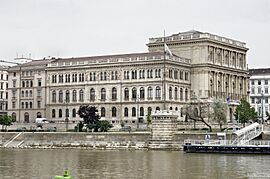
Budapest's culture is rich and varied, reflecting its size. Most Hungarian cultural movements started in the city. Budapest is an important center for music, film, theater, dance, and visual art. Artists are drawn to the city because the government supports the arts with good funding.
Budapest was named a "City of Design" in December 2015 and is part of the UNESCO Creative Cities Network.
Museums and Art Galleries
Budapest has many museums and galleries, 223 in total. They showcase Hungarian, European, and world culture and science. Some of the best examples are:
- The Hungarian National Museum
- The Hungarian National Gallery
- The Museum of Fine Arts (with works by Hungarian painters and European art)
- The House of Terror
- The Budapest Historical Museum
- The Aquincum Museum
- The Semmelweis Museum of Medical History
- The Memento Park
- The Museum of Applied Arts
- The Palace of Arts Budapest, which hosts contemporary art exhibitions.
Budapest has 837 monuments, showing many European art styles. The classical and unique Hungarian Art Nouveau buildings are especially notable.
Libraries for Learning
Many libraries in Budapest have special collections. The National Széchényi Library, for example, keeps historical items from before books were printed. The Metropolitan Szabó Ervin Library is important for the general education of the city's people. Other libraries include the Library of the Hungarian Academy of Sciences and the Parliamentary Library.
Opera and Theatres
Budapest has forty theaters, seven concert halls, and an opera house. During summer, outdoor festivals, concerts, and lectures add to the cultural scene, often held in historic buildings. The largest theater venues include the Budapest Operetta and Musical Theatre, the Hungarian State Opera House, the National Theatre, and the Palace of Arts (MUPA). The Budapest Opera Ball is an annual event held at the Opera House in late February.
Festivals and Performing Arts
Budapest hosts several annual festivals. The Sziget Festival is one of Europe's largest outdoor music festivals. The Budapest Spring Festival features concerts across the city. The Café Budapest Contemporary Arts Festival offers free music, dance, art, and other cultural events. The Budapest Wine Festival and Budapest Pálinka Festival, held in May, focus on food and drink. The Budapest Pride (or Budapest Pride Film and Cultural Festival) happens annually, usually with a parade on Andrássy Avenue.
Other festivals include the Budapest Fringe Festival, which brings over 500 artists for alternative theater, dance, music, and comedy shows. The LOW Festival is a cultural festival held in Budapest and Pécs from February to March. The Budapest Jewish Summer Festival, in late August, is one of Europe's largest.
Budapest has many symphony orchestras, with the Budapest Philharmonic Orchestra being the most famous. It was founded in 1853 and performs regularly at the Hungarian State Opera House. Budapest also has a lively jazz scene.
The dance traditions of the Carpathian Basin are unique in European dance culture. The city is home to several authentic Hungarian folk dance ensembles. Budapest is one of the few cities with a high school dedicated to teaching folk dance.
Fashion Scene
Budapest hosts a fashion week twice a year. Here, local fashion designers show their collections, and people from the fashion industry meet. Budapest Fashion Week also allows designers from other countries to present their work. Popular fashion brands like Zara, H&M, and Mango are common in the city's shopping malls and on its streets.
Luxury fashion brands such as Dolce & Gabbana, Gucci, and Prada can be found on Budapest's most prestigious shopping streets, like Fashion Street, Váci Street, and Andrássy Avenue.
Media and Entertainment
Budapest is a major center for the Hungarian entertainment industry. Many films, TV series, and books are set here. It is the largest center for film and television production in Hungary. In 2011, the media industry in Budapest employed over 50,000 people.
Budapest is Hungary's media hub. It is home to the main headquarters of Hungarian Television and other local and national TV and radio stations.
In 2012, Hungary had 7.2 million internet users (72% of the population) and 2.3 million mobile broadband subscriptions.
Delicious Cuisine
In modern times, Budapest developed its own special cuisine. It uses local products like lamb, pork, and regional vegetables. Modern Hungarian cuisine mixes ancient Asiatic elements with French, German, Italian, and Slavic influences. It's like a melting pot of European flavors, built on its own original Magyar cooking.
Many different groups, like Saxons, Armenians, Italians, Jews, and Serbs, settled in Hungary and added new dishes. Elements of old Turkish cuisine were adopted during the Ottoman era, such as sweets (like törökméz), quince (birsalma), Turkish delight, Turkish coffee, and rice dishes like pilaf. Meat and vegetable dishes like eggplant salads and stuffed peppers or cabbage (töltött káposzta) also came from Turkish influence. Hungarian cuisine was also influenced by Austrian cuisine during the Austro-Hungarian Empire.
Budapest restaurants offer a wide variety of food. You can find traditional regional dishes, mixes of different culinary styles, or new, innovative cooking techniques. Budapest's food shops are also known for their high-quality specialized products. These include places like Café Gerbeaud, one of Europe's oldest and most traditional coffeehouses, and the Gundel restaurant in the City Park.
Food lovers can also find top-quality meals at several Michelin-starred restaurants, such as Onyx and Costes.
Sports and Recreation
Budapest has hosted many global sporting events in the past. These include the 1994 IAAF World Cross Country Championships, 2017 World Aquatics Championships, and 2017 World Judo Championships. Budapest will also host the 2023 World Championships in Athletics and 4 matches for the UEFA Euro 2020 at the new 67,215-seat New Puskás Ferenc Stadium.
In 2015, Budapest decided to bid for the 2024 Summer Olympics, but later withdrew its bid.
Many Olympic, World, and European Championship winners live in Budapest. Hungary ranks 8th among all nations in the All-time Olympic Games medal table. Hungarians are known for excelling in fencing, swimming, water polo, canoeing, wrestling, and track & field. Besides classic sports, modern recreational sports like bowling, pool billiard, darts, go-karting, wakeboarding, and squash are very popular. Extreme sports are also growing. The Budapest Marathon and Budapest Half Marathon attract many people each year. The city's largest football stadium is named after Ferenc Puskás, a famous footballer.
Football is one of Budapest's most popular sports. The city has many football clubs in the top Hungarian League, such as Ferencvárosi TC and MTK Budapest FC.
The Hungarian Grand Prix in Formula One is held at the Hungaroring circuit just outside the city. This race has been part of the FIA Formula One World Championship since 1986. The track was resurfaced in 2016, and the Grand Prix deal was extended until 2026.
Budapest has two four-star UEFA stadiums: Puskás Aréna and Groupama Aréna. It also has two three-star UEFA stadiums: Hidegkuti Nándor Stadion and Bozsik Aréna.
Learning in Budapest
Budapest is home to over 35 higher education institutions, including many universities. Thanks to the Bologna Process, many qualifications from these schools are recognized across Europe. Medicine, dentistry, pharmacy, veterinary programs, and engineering are popular fields for international students in Budapest. Most universities offer courses in English and other languages for foreign students. Many students from other European countries spend a semester or two in Budapest through the Erasmus Programme.
| Name | Established | City | Type | Students | Academic staff |
|---|---|---|---|---|---|
| Budapest Business School | 1857 | Budapest | Public Business school | 16,905 | 987 |
| Szent István University | 1787 | Budapest | Public Classic university | 12,583 | 1,313 |
| Budapest University of Technology and Economics | 1782 | Budapest | Public Institute of technology | 21,171 | 961 |
| Corvinus University | 1920 | Budapest | Public Business school | 14,522 | 867 |
| Eötvös Loránd University | 1635 | Budapest | Public Classic university | 26,006 | 1,800 |
| Hungarian University of Fine Arts | 1871 | Budapest | Public Art school | 652 | 232 |
| Liszt Ferenc Academy of Music | 1875 | Budapest | Public Music school | 831 | 168 |
| Moholy-Nagy University of Art and Design | 1870 | Budapest | Public Art school | 894 | 122 |
| National University of Public Service | 2012 | Budapest | Public Classic university | 10,800 | 465 |
| Óbuda University | 1879 | Budapest | Public Institute of technology | 12,888 | 421 |
| Semmelweis University | 1769 | Budapest | Public Medical school | 10,880 | 1,230 |
| University of Physical Education | 1925 | Budapest | Public Classic university | 2,500 | 220 |
| Academy of Drama and Film in Budapest | 1865 | Budapest | Public Art school | 455 | 111 |
| Andrássy University Budapest | 2002 | Budapest | Private Classic university | 210 | 51 |
| Aquincum Institute of Technology | 2011 | Budapest | Private Institute of technology | 50 | 41 |
| Budapest Metropolitan University | 2001 | Budapest | Private Classic university | 8,000 | 350 |
| Budapest University of Jewish Studies | 1877 | Budapest | Private Theological university | 200 | 60 |
| Central European University | 1991 | Budapest | Private Classic university | 1,380 | 399 |
| International Business School | 1991 | Budapest | Private Business school | 800 | 155 |
| Károli Gáspár University of Reformed Church | 1855 | Budapest | Private Classic university | 8,401 | 342 |
| Pázmány Péter Catholic University | 1635 | Budapest | Private Classic university | 9,469 | 736 |
| Evangelical-Lutheran Theological University | 1557 | Budapest | Private Theological university | 220 | 36 |
Budapest's Global Connections
Budapest has many sister cities and partner cities around the world. Like Budapest, many of these are important and large cities in their own countries and regions. They are often the main political, economic, and cultural centers. The Mayor of Budapest aims to improve these relationships to share information and work together on city management, education, culture, tourism, and business.
Sister Cities Around the World
|
|
International Partnerships
Some of Budapest's districts are also twinned with smaller cities or districts of other large cities. You can find more details in the article List of districts in Budapest.
Images for kids
See also
 In Spanish: Budapest para niños
In Spanish: Budapest para niños


